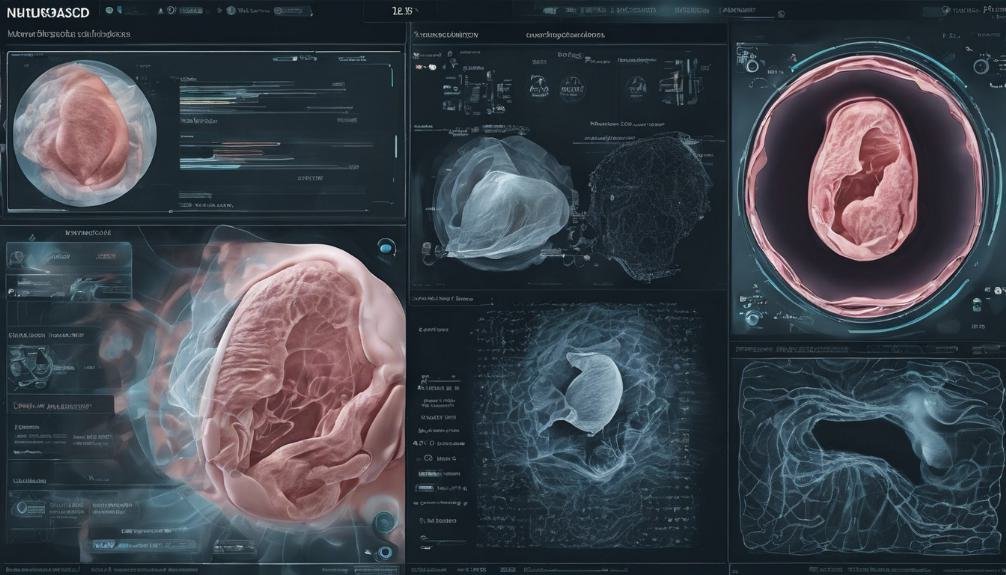AI in Ultrasound Imaging
Incorporating AI into ultrasound imaging has revolutionized the way medical professionals interpret and analyze images. The integration of machine learning algorithms, particularly deep learning models, has greatly enhanced diagnostic accuracy and workflow efficiency. But how exactly do these algorithms decipher intricate patterns in ultrasound images? The answer lies in the fascinating domain of artificial intelligence, where technology meets healthcare to redefine the standards of medical imaging.
Key Takeaways
- AI enhances diagnostic accuracy in ultrasound imaging through deep learning models.
- Improved workflow efficiency with automated image analysis and interpretation.
- Real-time decision support provided by AI algorithms for healthcare professionals.
- Automated abnormality detection enables early identification for timely interventions.
- AI enables customized treatment recommendations based on individual patient characteristics and imaging data.
AI-enhanced Image Analysis
Utilizing artificial intelligence (AI) in ultrasound imaging has revolutionized image analysis by enhancing the accuracy and efficiency of diagnostic interpretations. Machine learning algorithms, particularly deep learning models, have played a pivotal role in this transformation. These advanced algorithms can automatically analyze ultrasound images, identify patterns, and make predictions based on vast amounts of data.
Deep learning, a subset of machine learning, enables algorithms to learn intricate features directly from the input data. In ultrasound imaging, deep learning models can differentiate between normal and abnormal tissues with a high level of accuracy. By training on annotated datasets, these algorithms continuously improve their performance, making them invaluable tools for healthcare professionals.
The integration of AI into ultrasound image analysis hasn't only expedited the diagnostic process but also reduced the margin of error. With machine learning algorithms constantly evolving and learning from new data, the future of ultrasound imaging looks promising in terms of precision and efficiency.
Improved Diagnostic Accuracy
Enhancing diagnostic accuracy in ultrasound imaging has been a significant outcome of integrating artificial intelligence (AI) technologies into the field. Machine learning techniques have enabled AI algorithms to analyze ultrasound images with exceptional precision, leading to improved diagnostic outcomes in various clinical settings.
AI algorithms can detect subtle patterns and features within ultrasound images that may be challenging for human interpretation, enhancing the overall accuracy of diagnoses.
The utilization of AI in ultrasound imaging has shown promising results in enhancing diagnostic precision, particularly in tasks like tumor detection, fetal anomaly identification, and cardiovascular assessments. By leveraging vast amounts of data, AI algorithms can continuously learn and improve their diagnostic capabilities, ultimately leading to better clinical outcomes for patients.
These advancements in AI technology have the potential to revolutionize the field of ultrasound imaging by providing healthcare professionals with valuable insights and aiding in more accurate and timely diagnoses.
Enhanced Workflow Efficiency
You can improve workflow efficiency in ultrasound imaging by utilizing AI to speed up diagnoses and optimize image quality.
By leveraging AI algorithms, tasks such as image analysis and interpretation can be automated, reducing the time required for manual processing.
This not only enhances the overall efficiency of the imaging process but also allows for quicker decision-making in patient care.
Speeding up Diagnoses
Enhancing the speed of diagnoses in ultrasound imaging through AI integration is vital for improving workflow efficiency in healthcare settings. By utilizing AI algorithms to assist in the analysis of ultrasound images, healthcare providers can experience significant time savings in the diagnostic process.
The integration of AI technology can enhance diagnostic accuracy by quickly identifying patterns or abnormalities that may be challenging to detect with the human eye alone. This increased efficiency not only speeds up the diagnosis process but also leads to improved outcomes for patients by enabling timely interventions or treatments.
AI algorithms can analyze vast amounts of ultrasound data rapidly, providing healthcare professionals with essential insights in a fraction of the time it would take through traditional methods. The ability to expedite the diagnostic process through AI not only benefits patients by reducing wait times for results but also allows healthcare providers to optimize their workflow and focus on delivering quality care.
As AI continues to advance in ultrasound imaging, the speed and accuracy of diagnoses are expected to further improve, revolutionizing healthcare practices and ultimately enhancing patient outcomes.
Optimizing Image Quality
Analyzing ultrasound images with AI algorithms not only speeds up diagnoses but also plays a significant role in optimizing image quality and enhancing workflow efficiency in healthcare settings. Machine learning techniques enable image enhancement by reducing noise, improving resolution, and enhancing contrast. These algorithms can automatically adjust brightness and filter out artifacts, resulting in clearer images for accurate interpretation.
AI-based image optimization tools help standardize image quality across different operators, ensuring consistency in diagnostic quality. By automating tasks like image segmentation and feature extraction, machine learning algorithms streamline the workflow, allowing healthcare professionals to focus more on analysis and decision-making rather than manual image adjustments.
Furthermore, AI-powered image enhancement can assist in detecting subtle abnormalities that may have been overlooked, leading to early detection and better patient outcomes. By leveraging the capabilities of machine learning in optimizing image quality, healthcare providers can improve the efficiency and accuracy of ultrasound diagnostics, ultimately enhancing patient care.
Real-time Decision Support
Utilizing artificial intelligence algorithms, real-time decision support in ultrasound imaging enhances diagnostic accuracy and efficiency by providing immediate insights to healthcare professionals. Machine learning algorithms, combined with clinical expertise, play an important role in analyzing ultrasound images in real-time. These algorithms continuously learn and adapt, improving algorithm accuracy over time. By integrating clinical expertise into the algorithms, real-time decision support systems can offer tailored recommendations based on individual patient characteristics.
The user experience is a key consideration in the development of these systems. Interface design plays a significant role in how healthcare professionals interact with the real-time decision support tools. Clear and intuitive interfaces ensure that the insights provided by the algorithms are easily understandable and actionable.
Additionally, real-time decision support systems are designed to seamlessly integrate into existing ultrasound workflows, minimizing disruption and enhancing overall efficiency in diagnostic processes. With the continuous advancements in AI technology, real-time decision support in ultrasound imaging is poised to revolutionize the way healthcare professionals make diagnostic decisions.
Automated Abnormality Detection
With advancements in artificial intelligence technology, automated abnormality detection in ultrasound imaging has greatly enhanced diagnostic accuracy and efficiency for healthcare professionals. AI integration in ultrasound systems enables early detection of abnormalities, leading to improved patient outcomes by allowing for timely interventions and treatments.
By utilizing machine learning algorithms, these systems can quickly analyze vast amounts of ultrasound data to identify subtle signs of abnormalities that may be challenging for human eyes to detect.
Physician training on utilizing AI tools for automated abnormality detection is important to guarantee accurate interpretation of the results provided by the system. Healthcare professionals need to understand how to effectively integrate the AI technology into their diagnostic workflow to maximize its benefits.
Personalized Treatment Planning
You can leverage AI in ultrasound imaging for personalized treatment planning by generating customized treatment recommendations based on the specific characteristics of each patient's condition.
This tailored approach guarantees that patient care is optimized, taking into account individual variations in anatomy, pathology, and response to treatment.
Customized Treatment Recommendations
Tailored treatment recommendations based on individual patient characteristics and imaging data are now possible through advancements in AI technology in ultrasound imaging. AI-driven insights allow healthcare providers to analyze vast amounts of patient-specific information and imaging results efficiently. By incorporating personalized therapies into treatment planning, providers can improve patient outcomes and enhance overall clinical effectiveness.
AI algorithms can process intricate details from ultrasound images, such as tissue characteristics, blood flow patterns, and organ structures, to generate customized treatment recommendations. These recommendations are based on a combination of imaging data and patient-specific factors like medical history, genetic predispositions, and lifestyle habits.
By leveraging AI in ultrasound imaging, healthcare professionals can optimize treatment strategies to suit each patient's unique needs, leading to more precise interventions and improved clinical outcomes.
The ability to tailor treatment recommendations using AI technology marks a significant advancement in personalized medicine. By considering individual variations and utilizing advanced algorithms to interpret imaging data, healthcare providers can deliver more effective and targeted care, ultimately enhancing patient outcomes and quality of life.
Tailored Patient Care
Personalized treatment planning revolutionizes healthcare delivery by integrating patient-specific data and advanced AI algorithms to optimize care strategies. Tailored patient care guarantees that individuals receive individualized interventions based on their unique characteristics, leading to improved patient satisfaction and treatment outcomes. By leveraging AI in ultrasound imaging, healthcare providers can customize treatment plans to meet each patient's specific needs effectively.
Individualized care driven by AI algorithms allows for a thorough analysis of patient data, enabling healthcare professionals to identify personalized interventions that are most likely to result in successful treatment outcomes. This tailored approach takes into account factors such as the patient's medical history, genetic predispositions, and lifestyle choices to create a personalized care plan that addresses their specific health concerns.
Ultimately, personalized treatment planning in ultrasound imaging not only enhances the quality of care but also boosts patient satisfaction by offering a more targeted and effective healthcare experience. The integration of AI technology in tailoring patient care signifies a significant advancement in optimizing treatment strategies for better individual outcomes.
Future Trends and Innovations
Looking ahead, the integration of artificial intelligence (AI) in ultrasound imaging is poised to revolutionize the field with advanced automation and enhanced diagnostic capabilities. AI automation will streamline image acquisition, processing, and analysis, reducing the dependence on manual input and potentially decreasing human error. Diagnostic advancements enabled by AI algorithms will empower healthcare providers to make more accurate and timely decisions, leading to improved patient outcomes.
Ultrasound innovation is expected to expand beyond traditional imaging modalities, with future applications focusing on areas such as 3D/4D imaging, elastography for tissue stiffness assessment, and contrast-enhanced ultrasound for better visualization of blood flow. These advancements hold promise for enhancing the diagnostic accuracy of ultrasound imaging, particularly in challenging cases where subtle abnormalities may be easily missed.
Patient-Centric Care Benefits
The implementation of patient-centric care benefits in ultrasound imaging involves optimizing diagnostic processes to prioritize individual needs and outcomes. By focusing on communication strategies that enhance patient-provider interactions, healthcare professionals can guarantee a more personalized and tailored approach to ultrasound examinations. Utilizing AI technology to streamline workflows and improve diagnostic accuracy, patient satisfaction is greatly enhanced.
Communication strategies play an essential role in patient-centric care, ensuring that individuals are well-informed about their ultrasound procedures, results, and treatment plans. This transparent and empathetic communication fosters trust and confidence, leading to higher levels of patient satisfaction.
Furthermore, by customizing ultrasound imaging protocols based on the specific requirements and preferences of each patient, healthcare providers can deliver a more personalized and comfortable experience. This individualized approach not only improves diagnostic outcomes but also enhances the overall quality of care provided.
Conclusion
To sum up, AI in ultrasound imaging is like having a super-smart sidekick that never gets tired or makes mistakes. It's basically the Sherlock Holmes of medical technology, uncovering hidden clues and solving mysteries with lightning speed.
With its ability to automate analysis, provide real-time support, and personalize treatment plans, AI is the ultimate partner in crime for healthcare professionals.
So, grab your magnifying glass and get ready to revolutionize patient care with this cutting-edge technology.







